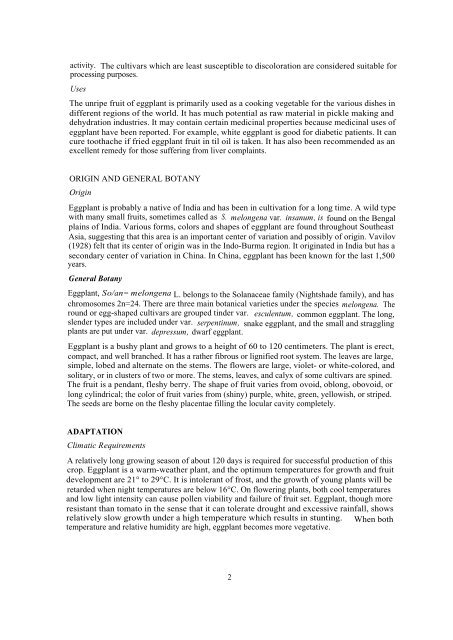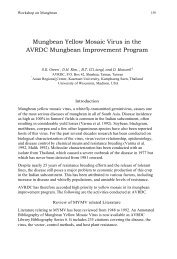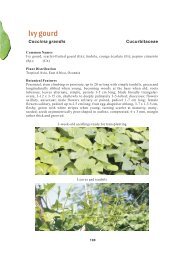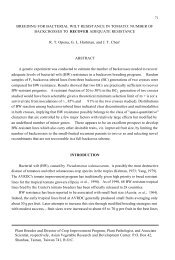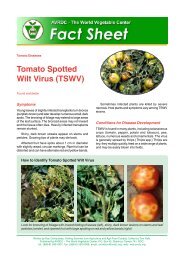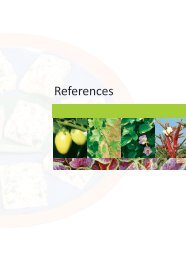CULTIVATION AND SEED PRODUCTION OF EGGPLANT NC Chen
CULTIVATION AND SEED PRODUCTION OF EGGPLANT NC Chen
CULTIVATION AND SEED PRODUCTION OF EGGPLANT NC Chen
You also want an ePaper? Increase the reach of your titles
YUMPU automatically turns print PDFs into web optimized ePapers that Google loves.
activity. The cultivars which are least susceptible to discoloration are considered suitable for<br />
processing purposes.<br />
Uses<br />
The unripe fruit of eggplant is primarily used as a cooking vegetable for the various dishes in<br />
different regions of the world. It has much potential as raw material in pickle making and<br />
dehydration industries. It may contain certain medicinal properties because medicinal uses of<br />
eggplant have been reported. For example, white eggplant is good for diabetic patients. It can<br />
cure toothache if fried eggplant fruit in til oil is taken. It has also been recommended as an<br />
excellent remedy for those suffering from liver complaints.<br />
ORIGIN <strong>AND</strong> GENERAL BOTANY<br />
Origin<br />
Eggplant is probably a native of India and has been in cultivation for a long time. A wild type<br />
with many small fruits, sometimes called as S. melongena var. insanum, is found on the Bengal<br />
plains of India. Various forms, colors and shapes of eggplant are found throughout Southeast<br />
Asia, suggesting that this area is an important center of variation and possibly of origin. Vavilov<br />
(1928) felt that its center of origin was in the Indo-Burma region. It originated in India but has a<br />
secondary center of variation in China. In China, eggplant has been known for the last 1,500<br />
years.<br />
General Botany<br />
Eggplant, So/an= melongena L. belongs to the Solanaceae family (Nightshade family), and has<br />
chromosomes 2n=24. There are three main botanical varieties under the species melongena. The<br />
round or egg-shaped cultivars are grouped tinder var. esculentum, common eggplant. The long,<br />
slender types are included under var. serpentinum, snake eggplant, and the small and straggling<br />
plants are put under var. depressum, dwarf eggplant.<br />
Eggplant is a bushy plant and grows to a height of 60 to 120 centimeters. The plant is erect,<br />
compact, and well branched. It has a rather fibrous or lignified root system. The leaves are large,<br />
simple, lobed and alternate on the stems. The flowers are large, violet- or white-colored, and<br />
solitary, or in clusters of two or more. The stems, leaves, and calyx of some cultivars are spined.<br />
The fruit is a pendant, fleshy berry. The shape of fruit varies from ovoid, oblong, obovoid, or<br />
long cylindrical; the color of fruit varies from (shiny) purple, white, green, yellowish, or striped.<br />
The seeds are borne on the fleshy placentae filling the locular cavity completely.<br />
ADAPTATION<br />
Climatic Requirements<br />
A relatively long growing season of about 120 days is required for successful production of this<br />
crop. Eggplant is a warm-weather plant, and the optimum temperatures for growth and fruit<br />
development are 21° to 29°C. It is intolerant of frost, and the growth of young plants will be<br />
retarded when night temperatures are below 16°C. On flowering plants, both cool temperatures<br />
and low light intensity can cause pollen viability and failure of fruit set. Eggplant, though more<br />
resistant than tomato in the sense that it can tolerate drought and excessive rainfall, shows<br />
relatively slow growth under a high temperature which results in stunting. When both<br />
temperature and relative humidity are high, eggplant becomes more vegetative.<br />
2


